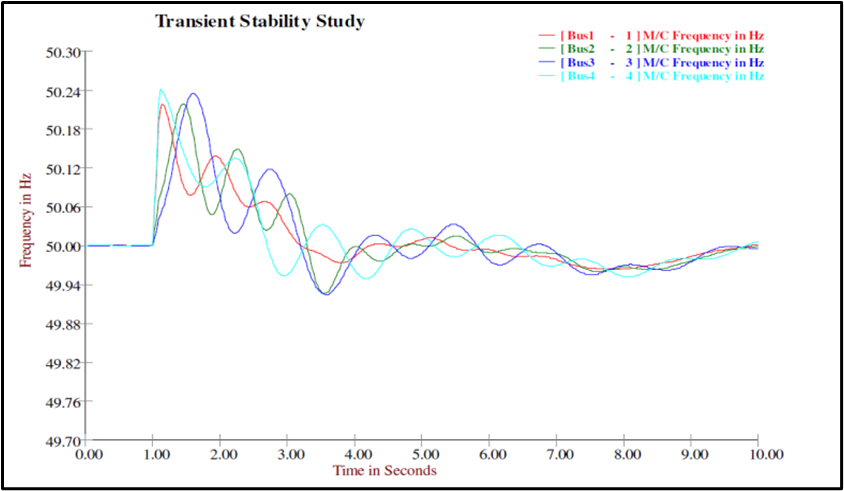

Power system security is the ability of the electrical network to operate reliably and stay stable during both normal and unexpected (contingency) conditions. It ensures that key system parameters remain within safe limits, even when there are disturbances like equipment failures or sudden changes in power demand.
The goal is to provide a continuous and reliable supply of electricity to consumers. Each important system parameter has specific operational limits. If all these limits are maintained – even during disturbances – the system is considered to be operating securely.
Inequality Constraints:
| Vimin ≤ Vi ≤ Vimax | fmin ≤ f ≤ fmax |
| Pgimin ≤ Pgi ≤ Pgimax | Qgimin ≤ Qgi ≤ Qgimax |
| Vi | – Voltage magnitude, |
| f | – Frequency, |
| Pgi | – Real power generated from ith unit, |
| Qgi | – Reactive power generated from ith unit. |
Total Power Generated from all the units = Total Power demand + Total Power loss
MIPDSA Suite
The Dynamic Security Assessment (DSA) Suite is a powerful set of advanced power system tools designed to evaluate system security based on the current operating state. It can run automatically in real-time without manual input or be used in offline mode to assess system conditions and simulate different scenarios.
Key Features of the DSA Suite:
- Advanced near real-time analysis for Voltage Stability Assessment Tool (VSAT), Transient Stability Assessment Tool (TSAT), and Small Signal Assessment Tool (SSAT).
- Supports redundant architecture for smooth operation between main and backup control centres.
- Utilizes multi-core CPU processing for faster performance.
- Sends automated alerts for limit violations via SMS and Email.
- Includes a native mobile app for real-time monitoring and interaction with the DSA server.
- Runs automatically at scheduled intervals based on real-time operating data.
- Offers on-demand analysis triggered by the user.
- Capable of integrating closely with online SCADA and EMS systems for continuous security assessment
- Supports detailed modelling of system components: Transmission Lines, Cables, OLTC Transformers, Synchronous Machines, Induction Motors, HVDC, SVC, STATCOM, AVR, Governors, Free programmable logic blocks and more.
- Models distributed energy sources such as Wind, Solar, Battery Storage and more.
- Includes intelligent modules for automatic contingency creation, ranking, and identification of critical contingencies for a current operating system state.
- The online system gives operators clear and timely information about security limits for each critical contingency.
- Recommends Remedial (preventive) actions when a critical contingency threatens current operations.
- Offers offline mode for simulating “what-if” scenarios based on the current operating state.
- Supports post-disturbance analysis using snapshots from the state estimator, allowing event reconstruction.
- Delivers web-based visualizations of stability curves, case comparisons, and more.
Modes of Operation
OFF-LINE DSAOff-line DSA (Dynamic Stability Analysis) involves detailed time-domain stability checks for all potential contingencies and different operating conditions. It is mainly used to determine power transfer limits across key system interfaces. Since it’s done off-line, there are no strict time constraints, allowing for thorough analysis across a wide range of conditions and contingencies. This includes simulating power transfers and contingencies, typically based on fault locations and specified fault-clearing times. These studies involve integration of the models under specific power transfer conditions and various contingencies, each defined by a fault location and a set fault-clearing time.
ON-LINE DSAOn-line DSA complements off-line analysis by factoring in real-time operating conditions. It generally follows a two-step process:
- Rapid Screening: Quickly narrows down which contingencies need in-depth evaluation, using methods that avoid lengthy numerical integration time.
- Time-domain Simulation: A more detailed simulation that uses numerical integration to unveil swing trajectories and voltage variations. This is done for a smaller set of contingencies identified in the first step as potentially critical.
- Data Collection & Conversion
Collect the current operating system state from SCADA/EMS in PSS/E format. Validate the necessary data and convert it to the required format for further analysis. - Contingency Identification
Based on a computed ranking index, identify the most critical contingencies for the next steps under the given operating system state. - Contingency Analysis
For each selected critical contingency, perform the following analyses:- LFA – Analyse the system’s operating state under each selected contingency.
- VIA – Calculate the voltage instability margin (Distance from Stability).
- TRS – Conduct transient stability analysis (Fault Simulations).
- DYS – Perform dynamic stability analysis (Frequency and Time domain).
Remedial actions are corrective steps taken by operators to restore system stability and prevent further disruptions. Based on analytical insights, these measures help maintain optimal power system performance and reliability.
Recommended Actions- Tap Control Optimization
Adjust transformer tap settings to maintain voltage stability and improve power system performance. - Shunt Reactor/Capacitor Control Optimization
Adjust the generator’s excitation system to optimize reactive power output and maintain system voltage stability. - Generator Excitation Control Optimization
Manage shunt reactor and capacitors to regulate voltage levels and enhance power system efficiency by balancing reactive power.


